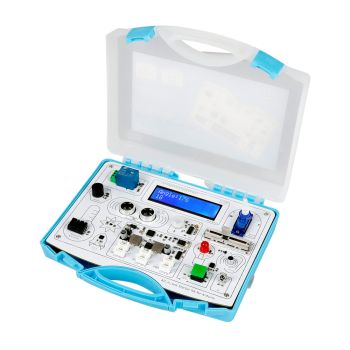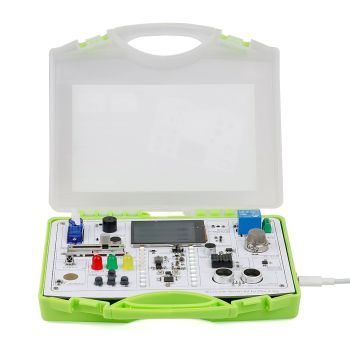Pressure & Temperature Sensor BMP180 Breakout

Ever wanted to build your own weather station using Arduino? Then the BMP180 breakout board with precision sensor from Bosch might interest you. The digital sensor on the board precisely measures the changes in barometric pressure and temperature. It uses the piezoresistive effect to gather the information. Since the pressure varies depending on height, the sensor can measure altitude too. Very low current consumption and voltage allow this type of sensor to be used in many modern devices.
The design is 5V ready with an onboard regulator for 3.3V. The breakout board’s standard current consumption is very low, only 5 µA. It uses an I2C interface, and the I2C address is 0x77. No soldering, nor need for distinguishing between SDA and SCL is required due to easyC. The sensor has integrated EEPROM memory with data for calibration. The pressure is measured in steps of 1hPa (=0.01hPa =0,01mbar), and 0.1°C for temperature.
Product usage tips:
If there is an error while using the breakout board, see if it’s connected properly. Take a look at the pinout. If everything is properly connected, check if the I2C address of the breakout board is correct prior to programming it. The I2C 7-bit address should be 0x77. If everything is correctly connected and the I2C address is right, look through your code once again. There might be some bugs in the code that are stopping the sensor from working as it should.
BMP180 breakout board works very well in combination with any Dasduino board and OLED I2C 0.96” display breakout board. All of them use easyC so they can be connected in a matter of seconds. The BMP180 sensor can measure the barometric pressure and temperature, while the OLED display can show them. The breakout board also comes with two mounting holes so you can attach it onto something and it won’t budge.
To keep the sensor working for a long while, we would advise you not to use it in extreme conditions. Going over or below the temperature range will surely damage the sensor. Same with the pressure. Keep track of the current going through it. Allowing too high of a current through the breakout board will burn the sensor and render it completely useless.
Key features
- Standard current consumption: 5 µA
- Standby current consumption: 0.1 µA
- Logic voltage level: 5V (on I2C header), 3V3 on easyC
- Operating voltage: 5V (onboard regulator for 3.3V)
- Pressure measurement span: 300 - 1100 hPa; ±0.02hPa deviation
- Altitude measurement span: 9000 m to -500 m above sea level
- Temperature measurement span: -40 to +85°C; ±2°C accuracy
- Communication: I2C (address: 0x77)
- Connectors: easyC x2
- Mounting holes: 2
- Dimensions: 22 x 22 mm / 0.9 x 0.9 inch






















